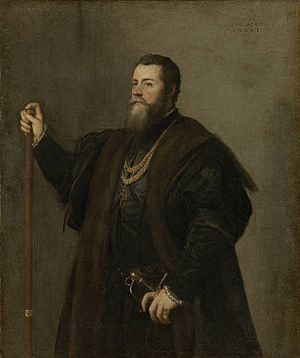Pedro de Toledo y Zúñiga facts for kids
Quick facts for kids
Pedro de Toledo
|
|
|---|---|

Portrait by Titian, 1542
|
|
| Viceroy of Naples | |
| In office 4 September 1532 – 21 February 1553 |
|
| Monarch | Charles V |
| Preceded by | Pompeo Colonna |
| Succeeded by | Pedro Pacheco de Villena |
| Personal details | |
| Born | 13 July 1484 Madrid, Crown of Castile |
| Died | 21 February 1553 (aged 68) Florence, Republic of Florence |
| Spouses | María Osorio y Pimentel, 2nd Marquise of Villafranca del Bierzo |
| Children | Eleanor of Toledo |
Pedro Álvarez de Toledo y Zúñiga (born July 13, 1484 – died February 21, 1553) was an important Spanish politician. He was the first powerful Spanish viceroy (a ruler acting for a king) of Naples. He served from 1532 to 1552. During his time, he made many improvements to the city of Naples and the southern Italian kingdom. He was also the father-in-law of Cosimo I de' Medici, Grand Duke of Tuscany.
Who Was Pedro de Toledo?
His Early Life
Pedro was born in 1484 near Salamanca in Spain. He was the second son of Fadrique Álvarez de Toledo, 2nd Duke of Alba. His family was very important. Through his grandmother, he was a second cousin to Charles V, Holy Roman Emperor, who was also the King of Spain. This connection was very helpful for his career.
Becoming Viceroy of Naples
Spain took control of the Kingdom of Naples in 1503. After France failed to take it back in 1529, Spain's control became very strong. For about 30 years, several less important viceroys ruled Naples. Then, Don Pedro arrived as viceroy in September 1532. He was sent to make big changes.
Don Pedro worked for years to rebuild and improve Naples. He made the old city walls bigger. He also built a completely new wall along the sea. Fortresses along these walls and up and down the coast were updated. The Arsenale, which was the naval shipyard, was also greatly expanded.
He also built a new palace for the viceroy. Near the palace, he built a dozen blocks of barracks. These were buildings arranged in a square grid with many stories. This was very new for Europe at the time. Today, this part of Naples is still called the "Spanish Quarter." His goal was to make Naples, the Gulf of Naples, and the whole southern Italian area very safe.

Don Pedro ruled very strictly. In 1542, he closed the Accademia Pontaniana, a famous academy. He made rules that allowed quick punishment for small thefts on public streets. It became a serious crime to carry weapons at night in the city. He was also very tough with powerful landowners in the countryside. He encouraged them to move into the city. This helped the central government have more control over them.
This shift also led to more people moving into Naples. Both rich landowners and poor farmers came to the city. By 1550, Naples had a population of 200,000 people. This made it the second-largest city in Europe, after Paris. Inside the city, he brought all the courts together. They were all moved to the same building, the Castel Capuano.
Don Pedro is also remembered for trying to bring the Spanish Inquisition to Naples in 1547. The Inquisition was a religious court known for being very harsh. When the plan was announced in May 1547, people protested right away. The protests quickly turned violent. It wasn't just a protest by common people. Many rich landowners in Naples and Salerno joined in. They worried that the Inquisition would take their money and property. Also, his Jewish financial advisor, Samuel Abravanel, and his wife, Benvenida Abrabanel, may have influenced him to stop the Inquisition.
Following orders from Emperor Charles V, Don Pedro gave up on the idea. The Inquisition was called off. In 1552, Charles V sent Toledo to Siena to solve a local problem there. This helped calm the people of Naples even more. Don Pedro died in Florence the next year. One of his daughters, Eleanor of Toledo, was the Duchess of Medici in Florence.
Don Pedro is still known today as a great city-builder. Many parts of Naples still show his influence. He was supposed to be buried in the church of San Giacomo degli Spagnoli in Naples. But because he died suddenly in Florence, he was buried in the Cathedral of Florence instead.
His Family
Don Pedro Álvarez de Toledo married Maria Osorio Pimentel in 1508. She was the 2nd Marchioness of Villafranca del Bierzo. They had seven children, including:
- Eleanor of Toledo: She married Cosimo I de' Medici, Grand Duke of Tuscany in 1539. They had children.
- García Álvarez de Toledo: He became the 4th Marquess of Villafranca in 1569.
See also
 In Spanish: Pedro de Toledo (1484-1553) para niños
In Spanish: Pedro de Toledo (1484-1553) para niños

